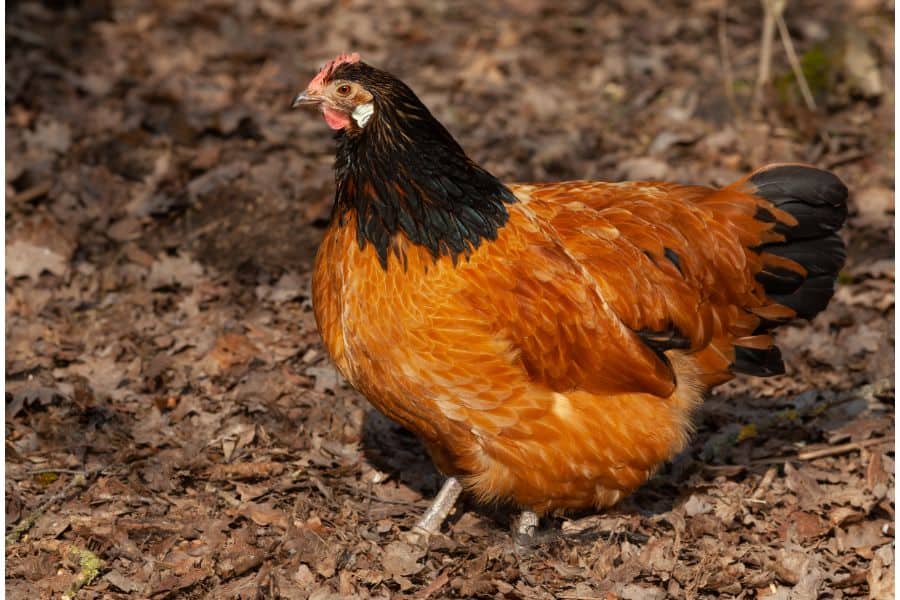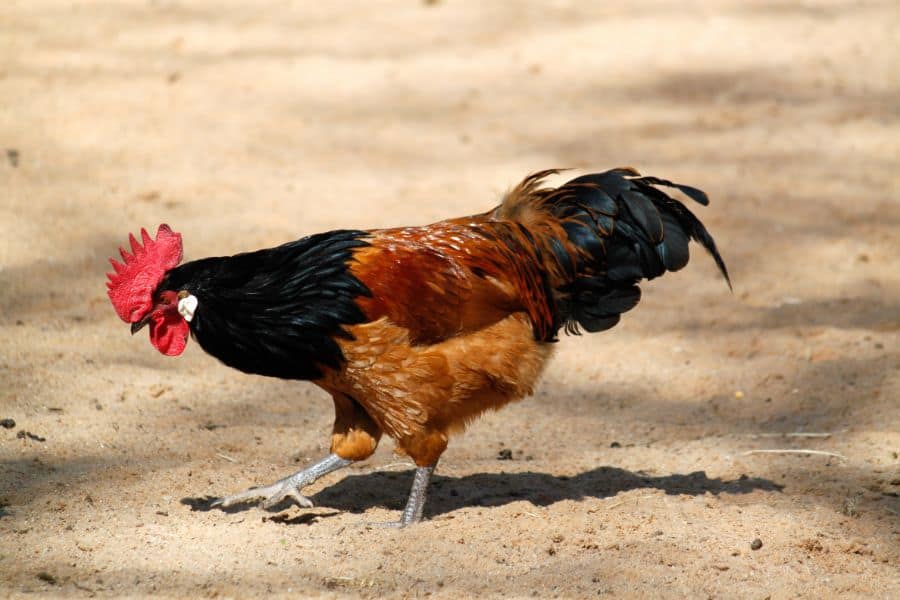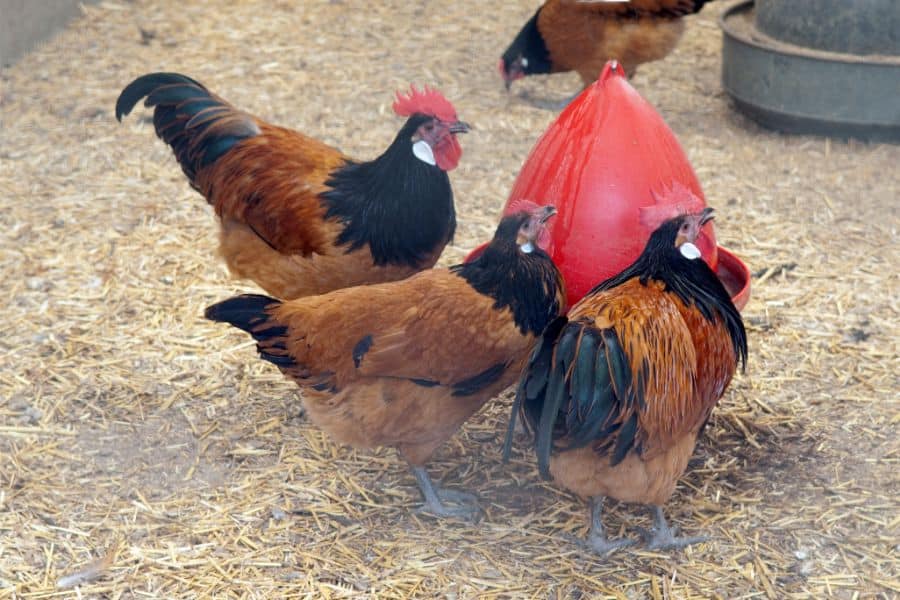Vorwerk chickens have the amusing distinction of being the only chicken breed that shares its name with a brand of household appliances. However, the story of this Germanic chicken is a little bit more interesting.
This is not a chicken you’re likely to come across in the US but it’s not as rare in certain parts of the world. Although it’s more than 100 years old at this point, this chicken is much younger compared to comparable breeds.

The appearance of the Vorwerk chicken is stunning, a quality it inherits from its ancestor. There is even a bantam version of the breed, but their qualities vary depending on which side of the Atlantic you’re on.
Vorwerk chickens can serve multiple purposes on your farm, and they are known to be able to handle different environments quite well. Their appetite is also something that will interest many farmers as well.
As interesting as it is, the Vorwerk doesn’t seem to be a challenging bird to raise. If you’ve been looking for an interesting European chicken for your backyard, read on to find out if the Vorwerk checks the right boxes for you.
Vorwerk Chicken Quick Facts:
| Names | Vorwerk, Vorwerkhuhn, Golden Lakenvelder (Incorrect) |
| Origin | Germany |
| Purpose | Eggs, meat, and exhibition |
| Egg Production/Year | 170+ |
| Climate | Cold-Hardy |
| Plumage Color | Buff body with black head, tail, and hackle. |
| Weight | Roosters: 7.05 lbs.
Hens: 5.5 lbs. |
| Personality | Active, alert, not shy, and not aggressive |
| Unique Fact | Have lower appetites than regular chickens |
History of Vorwerk Chickens
Development of the Original Vorwerk Chicken
The work to develop the Vorwerk chicken started in 1900. Oskar Vorwerk set out to develop a chicken that would meet three criteria:
- It would be medium-sized.
- It would be more practical around the farm rather than attractive.
- Its plumage would have a belted pattern similar to the Lakenvelder’s. However, the Vorwerk chicken’s base color would be dark golden and not white.
By 1913, Osker Vorwerk had succeeded in his quest and the chicken that was named after him was standardized.
Development of the Bantam Vorwerk Chicken
The Bantam versions of the Vorwerk chicken were developed separately in North America and Europe. Thus, the standards for these chickens in the US are different from the European standards.
The European Bantam Vorwerk chicken was reportedly developed around 1920.
One interesting detail about the American Bantam version of the Vorwerk chicken is that it was developed in New Ulm, Minnesota by a man called Wilmar Vorwerk in 1966. There is no indication that the two Vorwerks were related, despite the obvious coincidences.
The Bantam version was accepted into the Standard of Perfection in the US, but the larger Vorwerk is yet to be recognized.
Breeds Used in Development
The breeds used to develop the full-sized Vorwerk chicken include:
- Lakenvelder
- Buff Sussex
- Buff Orpington
- Andalusian
By 1966 when Wilmar Vorwerk was developing the Bantam version of the Vorwerk, these chickens were yet to find their way to the United States. Therefore, he had to create the American version of the Bantam Vorwerk using the following breeds:
- Lakenvelders
- Blue Wyandottes
- Buff Columbian Rosecombs
- Buff Wyandottes
- Black-tailed Buff Rosecombs
The Appearance of the Vorwerk Chicken
Oskar Vorwerk may have been focused on developing a utilitarian chicken breed, but by modern standards, the Vorwerk easily qualifies to be a show bird.
Vorwerk roosters have bodies that are a deep buff with a grey undercolor. Their heads, tails, and hackles are black. The hens are similarly colored but may have slightly buff lace patterns at the back of their heads and in their tail feathers.
There is a non-standard version of the Vorwerk chicken that has blue plumage where the original has black.
The legs and the feet are slate-colored while the beaks range from horn-colored to greyish-blue.
The eyes of Vorwerk chicken are bright orange and the earlobes are white. Their single combs and wattles are red.
Typically, for the full-sized birds, the roosters weigh around 7.05 pounds on the high side while females top out at 5.5 pounds.
In the US, the Male Bantams’ ideal weight is 765 grams, and for females, it is 650 grams. This contrasts with the European standard that requires male Vorwerk chickens to be 910 grams and females to be 680 grams.
Check out the video below to see some magnificent-looking Vorwerk chickens.
The Utility of Vorwerk Chickens
Production
Vorwerk chickens were developed to be all-rounders on the farm thus they can serve a variety of purposes.
The hens can lay around 170 eggs every year, though some are reported to have produced as many as 190 eggs in the same period. Their eggs are cream in color.
Like a good utility bird, the Vorwerk hen continues to lay eggs even during winter.
As far as meat goes, the Vorwerk is not the heftiest chicken breed you can get. The roosters will weigh about 7.05 pounds when they mature, which is acceptable for a medium-sized bird.
Perhaps important to the utility of this bird is the fact that they are reported to have smaller appetites than other chickens.
Vorwerk as Show Birds
Vorwerks are not uncommon in bird shows and one look at them tells you why. Vorwerks’ plumage and other features make both hens and roosters beautiful birds to exhibit.
In the US, only the Bantams have a breed standard. However, this breed standard is different from Europe’s so you should pay careful attention to the actual standard when choosing to exhibit your Bantam Vorwerks.
Caring for Vorwerk Chickens
Environment and Housing
The Vorwerk Chicken is no diva, so you won’t have to bend over backward to keep this chicken happy. As far as their environment and housing go, you should keep the following in mind when dealing with Vorwerk Chickens:
- Vorwerk chickens are hardy as their creator intended them to be. They can adapt and thrive in the environment they’re kept whether hot or cold.
- These chickens take well to free-ranging. They’re very active thus it’s a good idea to provide them with enough space either by letting them run around in the backyard or building a run.
- Vorwerks are known to handle confinement well.
- Some sources state that Vorwerks are capable of flying as high as 2 meters (6.56 feet). This can make it challenging to contain them in a run that is open at the top.
Diet
Many farmers can attest to the fact that feeding chickens is an expensive affair. This makes it a good thing that Vorwerk chickens are said to have lower appetites than your standard backyard fowl.
These chickens are active foragers and know how to get their food from their environment. This means it should be cheaper for you to feed Vorwerk chickens on your farm even if you’re buying commercial feed.
It’s a good idea to ensure your free-range chickens are still eating a diet that fully meets their nutritional needs. This is particularly important if you want them to grow at a certain rate or rely on them to regularly provide eggs.
As with any active bird that likes to roam, ensure that your Vorwerk chickens have access to all the fresh water they need.
Temperament
Vorwerk chickens are active and alert. Despite being good flyers, they are not known to take flight at every opportunity.
Vorwerks are not shy around people and can be easily tamed and handled.
Importantly, it is possible to keep more than one Vorwerk rooster without having to separate them as they aren’t always aggressive towards each other. However, don’t be surprised if this doesn’t turn out to be the case for you.
Breeding and Brooding in Vorwerk Chicken
Broodiness
Although Vorwerk hens are good backyard layers, they are not known for going broody. This doesn’t mean they’ll never go broody, but it’ll probably be a rare event.
Breeding Vorwerk Chicken
Since Vorwerks are unlikely to go broody, it is sensible to hatch the chicks in an incubator or to have a broodier hen on hand. The chicks mature relatively quickly after hatching.
If you’re intending to breed a few show birds, you’ll have to be extra-selective when choosing your stock. Two considerations you should keep in mind are:
- Breed standards require that the buff parts of Vorwerk chickens’ plumage do not have any black spotting. However, many farmers have struggled to prevent this in their chickens.
- Waiting until your pullets are in their second year before selecting for breeding is a good idea. This will ensure they have molted and will help identify pullets with black marks on their bodies.
Also Read:
Vorwerks Versus Golden Lakenvelders
The name Golden Lakenvelders is not uncommon in certain parts of the world such as the US when referring to Vorwerks. The similarities between these two breeds are obvious and Lakenvelders were indeed used in the development of Vorwerks.
However, Vorwerks are a different breed from Lakenvelders and are not a plumage variety of the Lakenvelder. This means that the offspring of two Vorwerk Chickens are chicks with all the attributes of Vorwerks.
A Beautiful Bird for Your Farm
The Vorwerk is neither the greatest layer nor meat bird you can add to your farm today. However, its unique character makes it a great bird to have in your flock, especially if you want a chicken that’s great for showing off.
This chicken was developed to be a great utility chicken and it achieved this objective. However, it didn’t attain widespread adoption and is rare, especially in countries like the US.
Vorwerk chickens are easy to raise and can thrive in different environments. The full-sized fowl and the bantam version are both great show birds.
Vorwerk chickens have the qualities of a good utility bird but also have eye-catching qualities. If you’ve been looking for an interesting exotic bird, this might just be it.


